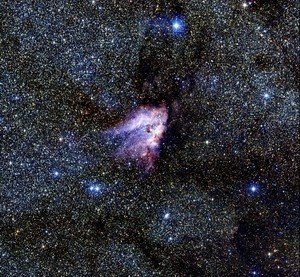... М16 < М17 > М18 ... Emission nebula and open star cluster M17Emission nebula and open star cluster M17 or Omega, Swan, Horseshoe, or Lobster Nebula is in the constellation Sagittarius (Sgr).  Equatorial coordinates (epoch J2000): Visual magnitude: 7,0m Optimum magnification for a telescope with observations of M17, depending on the aperture of the telescope (D), is about D/6-D/3. Higher magnifications of course add details, but lead to a strong drop in the brightness of the image, making it difficult to observe. The best month for observing M17 is July. At this time, the object is at midnight near its highest point in the sky, that is, it is less affected by light from the lanterns and atmospheric distortions. For observers in the northern latitudes:The nights in July are still quite light, so it makes sense to try to observe M17 also in August. The parameters of the open star cluster M17or Omega, Swan, Horseshoe, or Lobster NebulaEquatorial coordinates (epoch J2000):
The best month for observing M17 is July. At this time, the object is at midnight near its highest point in the sky, that is, it is less affected by light from the lanterns and atmospheric distortions. For observers in the northern latitudes:The nights in July are still quite light, so it makes sense to try to observe M17 also in August.
Nikolay Kurdyapin, kosmoved.ru |
© Copyright 2018-2020, kosmoved.ru
At a reprint of materials from this site link to the kosmoved.ru obligatory.
info@kosmoved.ru

